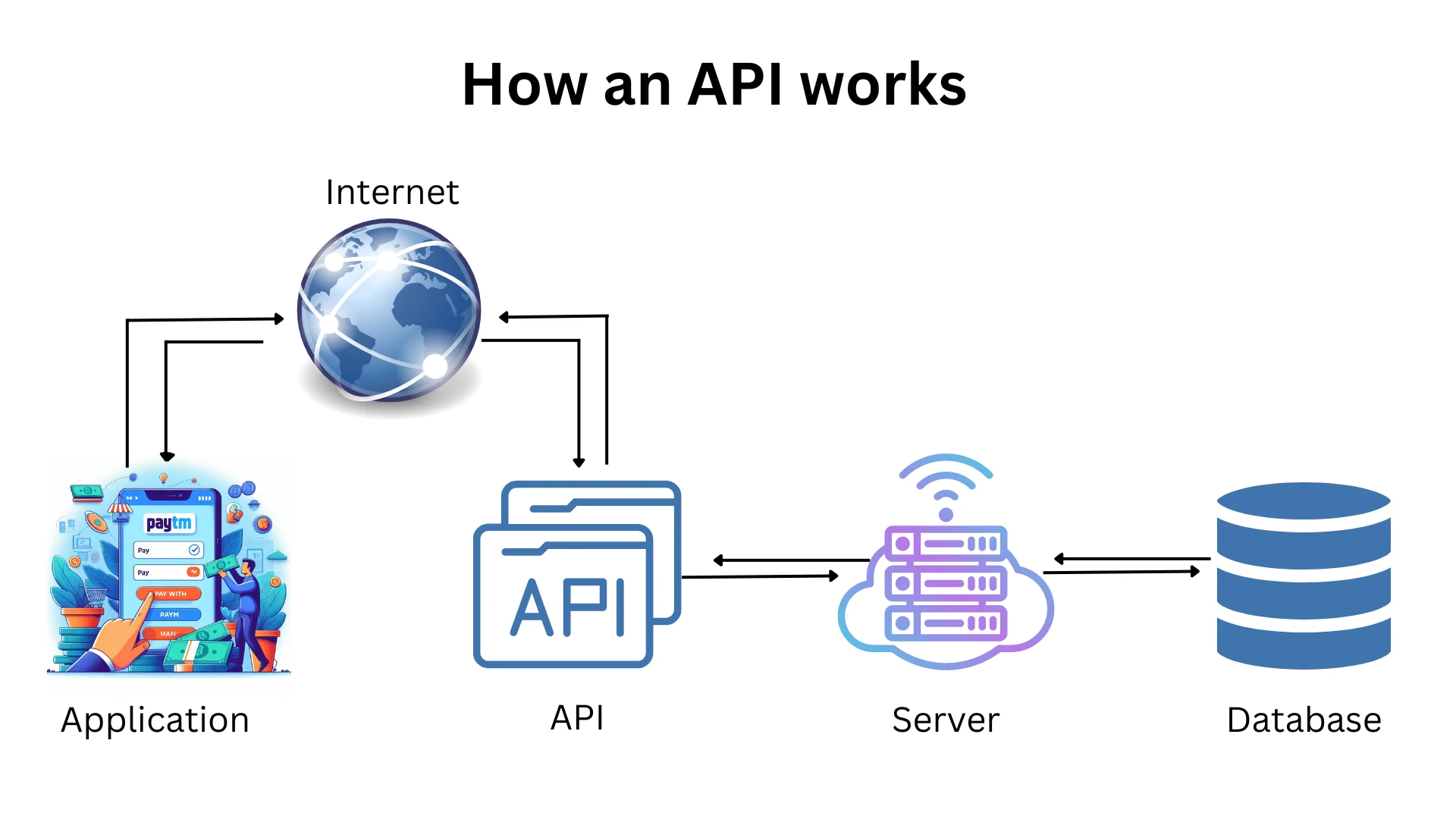Understanding the intricacies of APIs is paramount for businesses and developers looking to harness their potential for collaboration, innovation, and security.
What is an API?
An API, or application programming interface, serves as a set of predefined rules governing communication between different applications. Acting as an intermediary layer, APIs enable the exchange of data and functionality, fostering collaboration between external developers, business partners, and internal departments.
How APIs Work
APIs work by enabling various applications, systems, and devices to share data seamlessly. This involves a straightforward process of requesting and responding. When a user seeks information from an application, they send a request. This request is then directed to the API, which collects the required data and sends it back to the user in a response.
For instance, in the context of third-party payment processing:
- A user clicks ‘Pay with Paytm’ on an e-commerce site.
- An API initiates a request to obtain information.
- The request is processed through the API’s URI, involving a request verb, headers, and sometimes a request body.
- The API communicates with an external program or web server (third-party payment system).
- The server responds to the API with the requested information.
- The API transfers this data back to the initial requesting application (product website).
- This entire data exchange occurs within the computer or application, remaining invisible to the user.
Although the specifics of how information moves may differ among various web services, the communication between different systems consistently relies on APIs. Despite happening behind the scenes, users perceive this process as a smooth and seamless connection.
Key Benefits of using API
Using APIs lets you improve your processes, get rid of data blockages, avoid doing boring and repetitive tasks, make customers happier, keep employees interested, and much more. Now, let’s dive into understanding these advantages better.
Improved Collaboration:
The integration of almost 1,200 cloud applications facilitates seamless communication between platforms, streamlining workflows. This integration breaks down information silos, ultimately enhancing collaboration within the workplace.
Accelerated Innovation:
APIs provide businesses with the flexibility to forge new partnerships and introduce innovative services. The access to previously unexplored markets serves as a catalyst for digital transformation. Success stories like that of Stripe underscore the significant returns achievable through strategic API integration.
Data Monetization:
APIs act as magnets for developers, fostering a thriving community around the brand. The accessibility of valuable digital assets through APIs opens avenues for monetization, shaping what is known as the API economy. A notable example is AccuWeather’s self-service developer portal, which successfully attracted 24,000 developers within just 10 months.
System Security:
APIs play a crucial role in system security by creating a clear separation between requesting applications and responding service infrastructure. This is reinforced through authentication credentials, HTTP headers, cookies, and query strings. API gateways further contribute by effectively controlling access and minimizing security threats.
End-User Security and Privacy:
APIs add an extra layer of protection for personal users. Permission structures embedded in web browsers and mobile operating systems empower users to decide whether to grant or deny requests for location or data access. This user-centric approach ensures heightened security and privacy.
Types of APIs
There exist four fundamental types of Application Programming Interfaces (APIs), each serving distinct purposes in the realm of software development:
Open APIs: Open APIs are publicly accessible interfaces with clearly defined endpoints and standardized request/response formats. These APIs operate through the HTTP protocol, making them widely compatible and easy to integrate into various applications. Developers can leverage open APIs to create connections between different software systems, fostering interoperability in the digital landscape.
Partner APIs: Specifically tailored to facilitate collaboration with strategic business partners, Partner APIs are made accessible through a public API developer portal. However, to ensure security and controlled access, these APIs require an onboarding process and the provision of login credentials. Partner APIs play a crucial role in establishing and maintaining seamless interactions between affiliated entities.
Internal APIs: Internal APIs are intentionally concealed from external users and are utilized within an organization to enhance productivity and streamline communication. These APIs function as the backbone of internal systems, enabling different departments or teams to efficiently share data and functionalities without exposing them
Composite APIs: Composite APIs bring together multiple data or service APIs to provide a unified interface. This type of API is particularly useful in microservices architecture, where applications are composed of small, independent services. Composite APIs allow developers to make a single call to access various endpoints, reducing latency and enhancing efficiency. They play a crucial role in simplifying complex operations and improving the overall performance of applications in a microservices environment.
API Trends
The latest trends in APIs encompass various domains, reflecting the dynamic landscape of technological advancements:
In the realm of web interactions, REST (Representational State Transfer) and the Web are prominent. Web API calls are language-agnostic, accepting requests from any programming language. The preference for RESTful APIs is driven by their scalability and ease of implementation, making them a preferred choice for web-based interactions.
The integration of APIs with cloud computing has brought about significant transformations. Cloud computing facilitates the division of software into reusable components, leading to a shift from RPC (Remote Procedure Call)-based models to RESTful and functional programming. This transition allows for instant scalability in cloud environments.
APIs are increasingly perceived as services, with Service-Oriented Architecture (SOA) and microservices serving as noteworthy examples. This shift signifies a trend where services play a pivotal role, indicating a potential evolution in the perception of all APIs as services in the future.
Artificial Intelligence (AI) and machine learning are making substantial contributions to the API landscape. These technologies are leveraged for automated documentation and monitoring of API usage trends, enhancing efficiency and adaptability in managing APIs.
The publication and management of APIs have become critical aspects, with the company releasing the API maintaining control over design, security, reliability, and charging structures. Key considerations involve API testing, utilizing management platforms, and securing API endpoints to ensure seamless functionality and protection against potential vulnerabilities.
API testing is crucial for validating published APIs against user specifications. This process ensures that application endpoints and data-sharing functions operate as expected, thereby maintaining consistent functionality across diverse platforms.
API management encompasses multiple facets such as security, governance, analytics, and version control. Management platforms typically include essential components like a developer portal, lifecycle management tools, policy managers, analytics features, and an API gateway, ensuring comprehensive control and monitoring.
The security of API endpoints is a critical concern, as they serve as communication entry points between clients and servers. Recognized as attractive targets for potential attackers, these endpoints necessitate protective measures like rate limiting, input validation, and secure password storage to mitigate security risks effectively.
Conclusion
APIs are the backbone of modern technology, fostering collaboration, innovation, and security. Whether you’re a developer, business leader, or technology enthusiast, understanding and leveraging APIs is imperative for navigating the interconnected digital world. As businesses continue to evolve in the digital era, APIs will remain a key enabler of progress and transformation.
FAQ’s
What does API Management do?
API Management involves overseeing and controlling APIs throughout their lifecycle. It includes tasks such as defining rules, ensuring security, monitoring usage, and facilitating collaboration. API Management platforms offer features like a developer portal, analytics, and version control to streamline API operations.
What are the 4 types of API?
The four fundamental types of APIs are:
Open APIs: Publicly accessible with standardized formats.
Partner APIs: Facilitate collaboration with specific business partners.
Internal APIs: Concealed and used within an organization for enhanced productivity.
Composite APIs: Combine multiple data or service APIs to provide a unified interface.
How does the API work?
APIs facilitate seamless communication between applications through a request-response process. When a user requests information, an API processes the request, communicates with external systems if needed, and returns the data to the user. This exchange, often happening behind the scenes, enables smooth connections between different systems.


